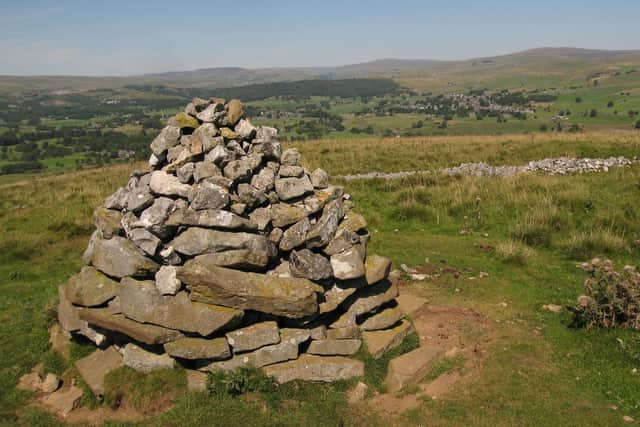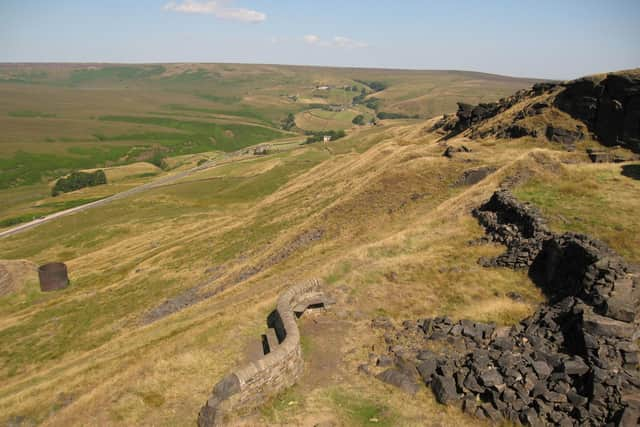Yorkshire's best seven tiny hills to visit this summer holidays
With the summer holidays now well under way, the time could be right to pay a visit to some local beauty spots with a difference. Here are seven small hills across the region that can be at the centre of a big day out.
Hall Tower Hill, Barwick in Elmet
This hill is really a big mound. In fact the hill is so small and gently rounded it could almost be a grown-over spoil heap. That couldn’t be further from the truth. The hill is a motte that provided a base for one of about 600 wooden forts built by the Normans as administrative centres after the Battle of Hastings.
Advertisement
Hide AdAdvertisement
Hide Ad

The ditch and ramparts date back to the Iron Age. In the Second World War the motte became a viewing platform for the Royal Observer Corps. You can still see its foundations. The motte used to extend to Wendel Hill just to the north before it was split in two by the Normans by a street called The Boyle, a name thought to have derived from bailey.
Grid ref: SE 398374.
Day out: A short walk leads you around both Hall Tower and Wendel Hills. See the panel beside the church. Well tended Barwick village is worth a wander too. The maypole is one of the tallest in the UK at 27 metres.
Pule Hill, South Pennines


At a lofty 437 metres, Pule Hill is the biggest of my tiny hills but still has a low profile by virtue of its location tucked away in the otherwise gently undulating Marsden Moor. The view from the summit includes the heart-shaped Redbrook Reservoir. Stride away from the path for about 100 metres to the north-east for fine views over Marsden. The big novelty up here, though, is the abandoned quarry workings and one of the Stanza Stones within them.
Sited at six locations across the South Pennines watershed, the stones were carved 10 years ago and feature verse about water composed by poet laureate and Marsden man Simon Armitage. Also look out for the poet’s bench nearby.
Grid ref: SE 032104.
Advertisement
Hide AdAdvertisement
Hide AdDay out: One of my favourite Yorkshire places, Marsden is the epitome of the gritty, traditional Yorkshire mill town and has a welcoming, Bohemian atmosphere especially during its renowned jazz festival every October. The main year-round attraction is Standedge Tunnel, the longest, deepest and highest canal tunnel in the UK.
Elbolton Hill, Wharfedale
When is a cave not a cave? When it’s the entrance to a pothole covered by a fence. That’s the case with Elbolton Cave, enticingly marked in script on the Ordnance Survey map at the top of the hill of the same name.
You’d have to be an expert and keen caver to enter. In 1888 a Revd Jones descended into it to find three human skeletons in a sitting position as if gathered around a fire.
They were surrounded by a rough stone wall and there was evidence that dogs or wolves had been released into the cave to remove their flesh! The intrepid clergyman unearthed a further nine skeletons along with bones of bears, reindeer and wolves. The rocks he dug out remain as a scree down the side of the hill.
Grid ref: SE 006615.
Advertisement
Hide AdAdvertisement
Hide AdDay out: Thorpe, at the base of the hill, is a lovely lost in time village. At the entrance to the walled green is a sign that tells the story of how villagers stole a maypole from Burnsall in 1992. The walk from Thorpe to Elbolton Hill and back is 1¾ miles.
Post Hill, near Pudsey
In the 1920s thousands of people flocked to Post Hill to watch motorbike scrambling races. Bikes tore up its precipitous 1 in 6 cobbled slope, some riders having to push and others being towed by rope. It was all very un-health and safety compliant in a what-the-heck sort of way with a flimsy wooden fence, rope or nothing between spectators and the action. A tractor making the ascent once flipped over, killing its passenger.
Marvel at the derring-do as you stand at the foot or top of the slope in the company these days largely of dog walkers and with not a motor to be heard. The Hill is named after the Yorkshire Evening Post which sponsored the motorbike races and was the location of a prisoner of war camp in the Second World War.
Grid ref: SE 239330
Day out: A walk around the Hill, designated a Leeds Nature Area, is about 5km. Combine it with lunch at the Beulah Bistro and Deli en route.
How Hill, Ripon
Advertisement
Hide AdAdvertisement
Hide AdDrawing the eye for some miles from all approaches, the tower on top of How Hill looks like it hopes to grow up to be a castle and is marked on the Ordnance Survey map as a church with steeple. That’s not strictly the case.
It was built in 1719 by John Aislabie on the site of a ruined mediaeval chapel as an eye-catcher for his Studley Royal Water Garden. The view from the tower is pretty good too, extending 50 miles on a clear day. The tower was used for gaming in the 18th century and as a Home Guard lookout point during the Second World War. You can access the tower on a permissive National Trust path.
Grid ref: SE 276670
Day out: Fountains Abbey and Studley Royal, a World Heritage Site, are very close by and provide one of the greatest days out in Yorkshire. The abbey ruins are stunning and, in contrast to How Hill, almost hide in a valley.
The Nab, North York Moors
The Nab noses into Douthwaite Dale like the bow of a ship. The interest here comes from pillow mounds that pockmark its top. Not to be confused with nearby prehistoric burial mounds, they are the legacy of rabbit farming. Thirty-two mounds were constructed as a small warren probably by the shepherds of Douthwaite Hall in the late 17th or early 18th centuries.
Advertisement
Hide AdAdvertisement
Hide AdIt fell out of use in the late 19th century following the decline of rabbit farming. The rounded mounds are rectangular in plan, about 5m by 8m and surrounded by a 2m-wide ditch. The Nab is an easy bound up from the footpath between Gillamoor and Hutton-le-Hole. The name for this and other, similarly named hills in the Moors, derives from the Old Norse words nabbr or nabbi meaning a projecting peak or knoll.
Grid ref: SE 695904
Day out: Hutton-le-Hole is deservedly one of the most popular destinations in the North York Moors. The broad green with its white fence, beck and footbridge makes for a lovely little wander. I particularly like the Ryedale Folk Museum with its quirky collection of 20 vernacular buildings.
Cat Nab, Saltburn-by-the-Sea
Possibly named after wild cats that allegedly once lived on it, this hill wins my ‘king of the castle’ award. Spot it while visiting the car park, Ship Inn or ice cream and fish and chip shop immediately below and it’s hard not to resist a scamper up whatever your age.
It takes about a minute but your hands will push on your thighs throughout. Its most notable feature is the small, white chapel-like mortuary at its base which was built in 1882 to house bodies washed up from the sea up and used for this purpose until the 1960s.
Grifd ref: NZ 669215
Advertisement
Hide AdAdvertisement
Hide AdDay out: Saltburn Valley Gardens provide an excellent alternative to more obvious wanders along the beach or down the pier and a real taste of the town’s Victorian promenading heyday. The retro Saltburn Miniature Railway ensures easy access for all ages and abilities.